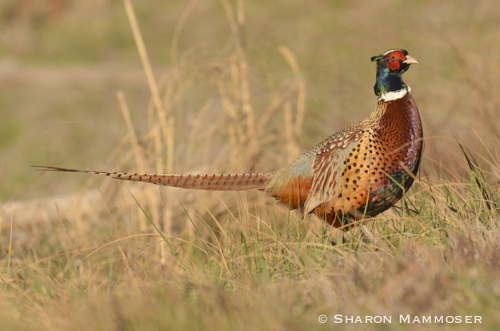 Have you ever seen a ring-necked pheasant? Did you get a good, close-up look at it? Was it a striking male or one of the duller females?
Have you ever seen a ring-necked pheasant? Did you get a good, close-up look at it? Was it a striking male or one of the duller females?
The first time I ever saw a live, wild ringed-neck pheasant was when I was a teenager, out exploring the wild land around my house in western New York. Of course, as was my custom, I had my trusty camera with me–a Minolta back then that I had saved up for with my babysitting money. It was land I knew well, having visited many times before. Even then I had an intimacy with the land, knew things about it from hours and hours of unstructured time wandering freely. I knew where the turkeys hung out, where I was likely to see an owl, where the fox regularly left his scat, what flowers bloomed in the forest and where the best place to see deer was. I spent many hours learning the land and always hoping to see something exciting.
On this day I first heard the pheasant–though as the time I didn’t know what it was–and then I saw a male running across an open area. I practiced the art of stalking, hoping to get a decent photo but of course back then I did not have a very strong telephoto lens and so although I got pictures, the bird is just a tiny speck in the frame, visible only if you study it closely.
Since then I have learned more about this bird and have gotten a chance to see some in the wild. On my recent trip to Nebraska I was blessed with the good fortune of seeing some close enough for some full-frame shots (of course the 600mm lens helped too!)
Let’s see what we can learn about this colorful game bird:
1. Ring-necked pheasants are NOT native to the US. Instead they were brought here from Asia in the 1880’s. Now they can be found throughout the northern US and Canada where there are open fields and weedy roadsides.
 2. Males have spectacular plumage that can be different colors according to how the light hits it–from purple to blue, green, teal, red and everything in between. Females are a dull brown, of course so they can blend into their surroundings when they are nesting. They are 20-36 inches long, including their long tail. They weigh 2-3 pounds.
2. Males have spectacular plumage that can be different colors according to how the light hits it–from purple to blue, green, teal, red and everything in between. Females are a dull brown, of course so they can blend into their surroundings when they are nesting. They are 20-36 inches long, including their long tail. They weigh 2-3 pounds.
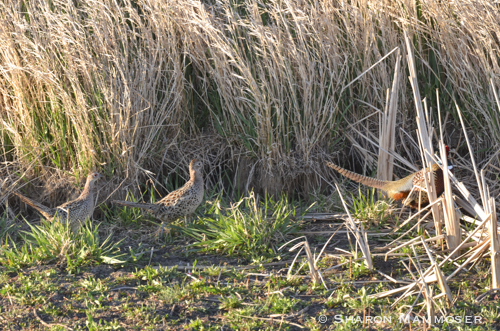
3. Speaking of nesting–this is done on the ground. Females use their bodies to create a small depression in the ground, surrounded by tall vegetation. She will line the nest with feathers from her breast as well as fine twigs, grass, corn husks and other soft materials.
4. She lays a clutch of 7-15 olive-brown to blue-gray eggs and will incubate them for 23-28 days.
5. When the chicks hatch they are already covered in down, and their eyes are open. Amazingly, they leave the nest right away, following mom and learning to feed themselves. They can fly at 12 days but will stay with mom for 10-12 weeks before heading out on their own.
6. Females will sometimes lay their eggs in the nests of another grassland bird–called a prairie chicken (Read more about these HERE). The pheasant eggs typically hatch before the chicken eggs and then the female prairie chickens feed those babies rather than their own, often causing their own to die.
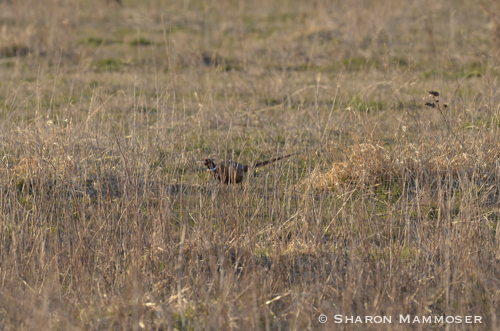
7. Ring-necked pheasants take dust baths to remove oil, dirt, parasites, dead skin cells, old feathers, and the sheaths of new feathers.
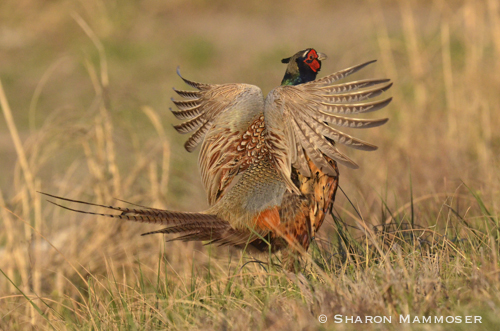
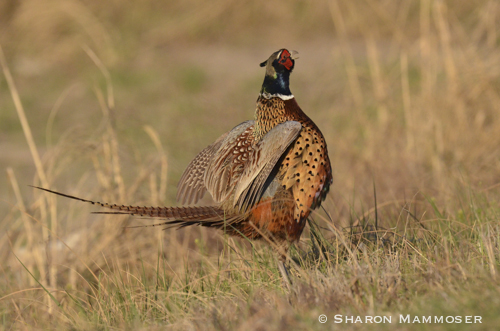 8. Like other members of the grouse family, pheasants have powerful breast muscles–have you ever been walking in a field or in the woods and heard one of these birds? They shoot out of the brush with a loud burst of noise and then veer off at a high speed–sometimes as much as 40 miles per hour! Have you ever seen or heard this?
8. Like other members of the grouse family, pheasants have powerful breast muscles–have you ever been walking in a field or in the woods and heard one of these birds? They shoot out of the brush with a loud burst of noise and then veer off at a high speed–sometimes as much as 40 miles per hour! Have you ever seen or heard this?
9. Ring-necked pheasants have a diet that changes throughout the year–much like many other birds that don’t migrate. In spring and summer they feed on insects, spiders, earthworms, snails and other invertebrates, as well as fresh greenery. In fall and winter they eat seeds, grasses, roots, fruit, nuts, leaves and insects when they find them.
10. Ring-necked pheasants do not migrate or hibernate but stay active. During extreme winter weather, pheasants can go up to two weeks without feeding by reducing their metabolism and energy requirements.


